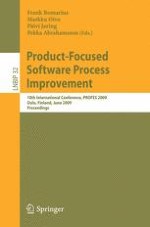On behalf of the PROFES Organizing Committee we are proud to present the proce- th ings of the 10 International Conference on Product Focused Software Process - provement (PROFES 2009), held in Oulu, Finland. Since the first conference in 1999, the conference has established its place in the software engineering community as a respected conference that brings together participants from academia and industry. The roots of PROFES are in professional software process improvement motivated by product and service quality needs. The conference addresses both the solutions found in practice as well as relevant research results from academia. To ensure that PROFES retains its high quality and focus on the most relevant research issues, the conference has actively maintained close collaboration with industry and sub- quently widened its scope to the research areas of collaborative and agile software development. A special focus for 2009 was placed on software business to bridge research and practice in the economics of software engineering. This enabled us to cover software development in a more comprehensive manner and tackle one of the most important current challenges identified by the software industry and software research community – namely, the shift of focus from “products” to “services. ” The current global economic downturn emphasizes the need for new methods and so- tions for fast and business-oriented development of products and services in a gl- ally distributed environment.
